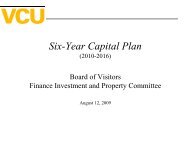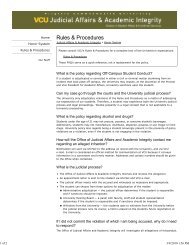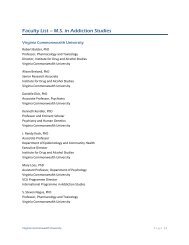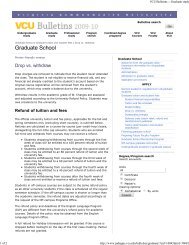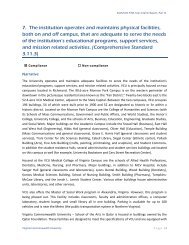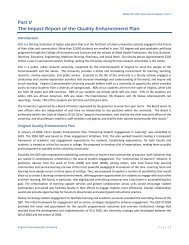4. The institution identifies expected outcomes, assesses the extent ...
4. The institution identifies expected outcomes, assesses the extent ...
4. The institution identifies expected outcomes, assesses the extent ...
Create successful ePaper yourself
Turn your PDF publications into a flip-book with our unique Google optimized e-Paper software.
SACS/COC Fifth-Year Interim Report, Part III.<br />
way findings are reported and used for continuous improvement. Assessment plans in this tier need<br />
some additional work in order to move into <strong>the</strong> upper tier of quality. <strong>The</strong> following are examples of<br />
programs having assessment plans in <strong>the</strong> middle tier:<br />
<br />
<br />
<br />
<br />
Engineering, M.S. (School of Engineering): student learning objectives are well written; some<br />
good measures (e.g., <strong>the</strong>sis review, presentations/publications, performance review [for non<strong>the</strong>sis<br />
students] with rubric); eliminated weaker measures (grade point average and course<br />
completion) in 2008-2009; still need to develop <strong>the</strong>sis rubric and to ensure that both rubricbased<br />
measures are implemented in future cycles<br />
Information Systems, M.S. (School of Business): reasonably well-developed student learning<br />
objectives; all 13 measures are based on assignments in a particular course (an assessment<br />
approach that complies with AASCB accreditation standards); all achievement targets are nonspecific<br />
and all findings are vague; entered findings for 2008-2009, but had not entered <strong>the</strong>m<br />
since 2005-2006<br />
Rehabilitation Counseling, M.S. (School of Allied Health Professions): overall strong plan tied to<br />
<strong>the</strong> Council on Rehabilitation Education accreditation standards; <strong>the</strong> same four measures are<br />
used for each of <strong>the</strong> seven student learning objectives and it is difficult to determine how <strong>the</strong><br />
measures map specifically to <strong>the</strong> individual learning objectives because <strong>the</strong> supporting<br />
documents are not uploaded in WEAVEonline; some reliance on course grades; findings<br />
reported annually and discussed by faculty in individual and group settings<br />
Urban and Regional Studies, B.S. (College of Humanities and Sciences, School of Government<br />
and Public Affairs): student learning objectives address important knowledge, skills, and values,<br />
but could be refined/disaggregated for easier measurement; cannot determine how measures<br />
were validated (uses nine items for entry and exit testing); in last two cycles for which findings<br />
are reported, no data for entry exam; though all three findings for 2008-2009 show target is<br />
partially met, no action plans developed; thoughtful responses to analysis questions,<br />
demonstrating thorough review of findings and curricular changes implemented to improve<br />
student learning<br />
Lower Tier<br />
Assessment plans in this tier have shortcomings that outweigh strengths. Clear improvement is needed<br />
for plans in this tier. Programs in this tier are of concern to <strong>the</strong> Office of Assessment and will be<br />
targeted for future consultation. <strong>The</strong> following programs are examples of assessment plans in <strong>the</strong> lower<br />
tier:<br />
<br />
Art History, B.A. (School of <strong>the</strong> Arts): all objectives are programmatic; in 2008-2009 cycle,<br />
eliminated <strong>the</strong> only student learning objective (related to knowledge of history of art) and<br />
added several programmatic objectives; measures are vague or in development; need rubric for<br />
internship evaluation; though entered findings for 2008-2009, had not reported findings since<br />
2004-2005; overall, needs extensive work on objectives, measures, targets, and reporting<br />
Virginia Commonwealth University P a g e | 26



